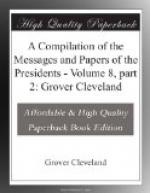From these data it would appear probable that the rocks are a prolongation of the western slope of the great range called by Mr. Featherstonhaugh, in his report as United States geologist, the Atlantic ridge. This formation, which is but a few miles in width where it crosses the Hudson, appears gradually to widen as it proceeds to the north, and was on the St. Lawrence found to prevail both at the river Du Loup and at Grand Metis, dipping in the two places in opposite directions and covered in the interval by the thick diluvial deposits which form the valley of the Trois Pistoles. To render the analogy more complete, in the valley of the outlet of the Little Lake (Temiscouata) was found a vein of metalliferous quartz charged with peroxide of iron, evidently arising from the decomposition of pyrites, being in fact the same as the matrix of the gold which has been traced in the talcose slate formation from Georgia to Vermont; and on the western shore of the Temiscouata Lake, about a mile to the south of Fort Ingall, lie great masses of granular carbonate of lime, identically resembling the white marbles of Pennsylvania, Westchester County, N.Y., and Berkshire County, Mass.
If the latter be in place, which, although probable, was not ascertained beyond all question, the primitive carbonate of lime has exactly the same relation to the slaty rocks which it bears in the latter locality.
The formations which have been spoken of appear to occupy the whole extent of the country explored by the parties of Professor Renwick. Everywhere the streams were found cutting through rocks of slate. On the summits of many of the hills were found weathered masses of angular quartz rocks, showing that while the slate had yielded to the action of the elements, the harder and less friable rock had kept its place. The ridges which intervene between the St. Lawrence at the river Du Loup and Lake Temiscouata have the character, so well described by Elie de Beaumont, of mountains elevated by some internal force.
To the eastward of Lake Temiscouata, on the other hand, the country has the aspect of having once been a table-land, elevated on the average about 1,700 feet above the level of the sea, and of having been washed by some mighty flood, which, wearing away the softer rocks, had cut it into valleys, forming a complex system incapable of being described in words and only to be understood by inspection of a map.
2.—COMPARISON OF THE ELEVATIONS OF THE BOUNDARY LINE CLAIMED BY THE UNITED STATES WITH THOSE OF THE “AXIS OF MAXIMUM ELEVATION” OF MESSRS. FEATHERSTONHAUGH AND MUDGE.
For the purpose of exhibiting the relative claims of the two lines to the exclusive epithet of “the highlands” in the most clear and definite manner, each of them will be considered as divided into three portions, which will be contrasted with each other by pairs The first portion of each of the lines is that which lies nearest to the point of bifurcation, the residue of the American line is divided at the source of the Ouelle, the remainder of the line of Messrs. Featherstonhaugh and Mudge at that of the Aroostook Metjarmette portage is taken as the point of bifurcation, whence waters run to the Penobscot, the St. John, and the St. Lawrence.




